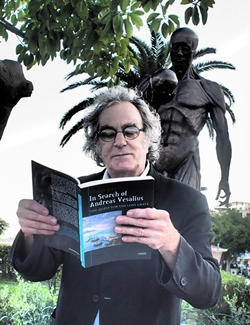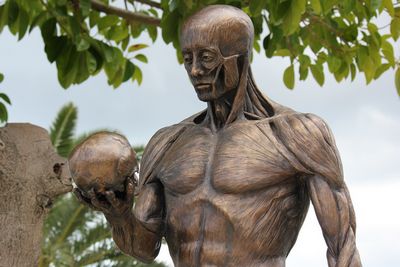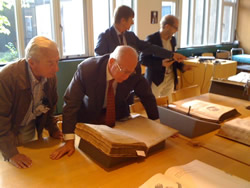This article is part of the series "A Moment in History" where we honor those who have contributed to the growth of medical knowledge in the areas of anatomy, medicine, surgery, and medical research.
If you arrived directly to this article, the first article in this three-page series can be read HERE
Bryan Green reading his poem in Theo Dirix's
book “ In Search of Andreas Vesalius”
Click on the image for a larger version
I would like to shine a light on my husband poet /sculptor Bryan Green , who wrote a poem on Vesalius that is published in Theo’s book; “In Search of Andreas Vesalius: The Quest for the Lost Grave” and gave a performance at the Fabrica Vitae exhibition opening.. Bryan has constantly worked behind the scenes editing many letters, articles, books, and leaflets, I couldn’t have done it all without his help and advice. He also made the long lorry journey to Zakynthos from Belgium with me and our friend James Gatehouse to deliver the monument.
Vesalius Continuum also marked the start of our touring exhibition “Fabrica Vitae” curated by Eleanor Crook, my sister Chantal Pollier, and myself. The exhibition toured all over Europe and the US with the help and support of Theo Dirix and Belgian Embassies world wide .
The conference and accompanying events could not have happened without financial funds and I hereby would like to thank all our sponsors: Professor Peter Abrahams with his infectious energy and professor Robert Jordan; St Georges University of Grenada, Ruth Richardson and Brian Hurwitz and Mark Gardiner for getting funding from the Wellcome trust, Marie Dauenheimer and the Vesalius Trust, BIOMAB, Ann van the Velde and The University of Antwerp, The AEIMS and MAA, William Nagels, warmly thank the local authorities and the mayor of Zakynthos, ARSIC, Theo Dirix, and Stephen Joffe, and a special thank you also Stephen for writing a beautiful foreword for our book In the Shadow of Vesalius.
You can imagine after such an exciting and wonderful adventure, which took quite a few years to organize, and a quite a few years to reminisce over, we decided we wanted to keep the momentum going and thus the Vesalius triennial was born.
In 2017 BIOMAB, in collaboration with Vesaliana, organized the first triennial in Zakynthos ‘Uniting Medicine with Poetry, History and Culture’
It seems like another world in which we made our plans for the 2nd edition of the Vesalius Triennial Congress, 4 months before the COVID-19 pandemic lock down. From the vain belief that COVID-19 would not hit most countries, to hopes that everything would have blown over by 13th November 2020 (the day when the next Vesalius Triennial Congress would take place in Antwerp) to realizing that we were going to have to take action, the scientific committee has transformed from one in which everyone knew their time-tried and perfected role, to one requiring invention in uncharted territory.
Professors Vivian Nutton and Omer Steeno
looking at a first edition of the Fabrica
Canceling the 2nd Vesalius Triennial was not a welcome prospect , since facilitating human communication is the corner stone of a scientific community. So we set sail for the vast virtual-reality realm. To discover just how far we could delve into virtual communication with a dedicated but small organising committee, was an eventful, insightful voyage. Sadly after long and careful consideration and several online meetings we finally decided to postpone all international congress keynote lectures and educational sessions until 2023.
However we would like to invite all the friends of Vesalius for a virtual book launch on Nov 13th we will soon post the event details on how to register for this event on social media, and on Vesalius continuum website
The book "In the shadow of Vesalius" can be ordered here: http://garant.be/shadow-of-vesalius/
Finally I would like to thank everyone who has been part of this adventure, special thank you to Professor Dr. Efrain Miranda ( Clinical Anatomy) for his continuous support, EBSA, Prof. Stefanos Geroulos, Vasia Hatzi (MEDinART), Pavlos Plessas, Nicos Varvianis, Maria Sidirokastriti-Kontoni & Fr. Panagiotis Kapodistrias, the many wonderful speakers, the local organisers, our Keynote speaker Professor Martin Kemp for his wonderful contribution, Eleni Andrianaki; ibis el greco , the wonderful delegates, the artists of the Fabrica Vitae exhibition, the museum and universities where we took our exhibition, a special thank you to Juris Salaks and Ieva Lebiete for hosting our exhibition at the Stradins museum and for all the help and support, Apostolis Sarris, Nikos Papadopoulos, Sylviane Déderix, Jan Driessen, Theo Dirix, Chr. Merkouri.and to the all the friends of Vesalius who like to keep his spirit alive.
Pascale Pollier-Green
Oct 2020
Personal note: I would like to thank Pascale Pollier-Green for authoring this series of articles and wish Professor Robrecht Van Hee the best success publishing this new book on the history and influence of Andreas Vesalius on anatomy, medicine, science, and the Arts. Dr. Miranda.





